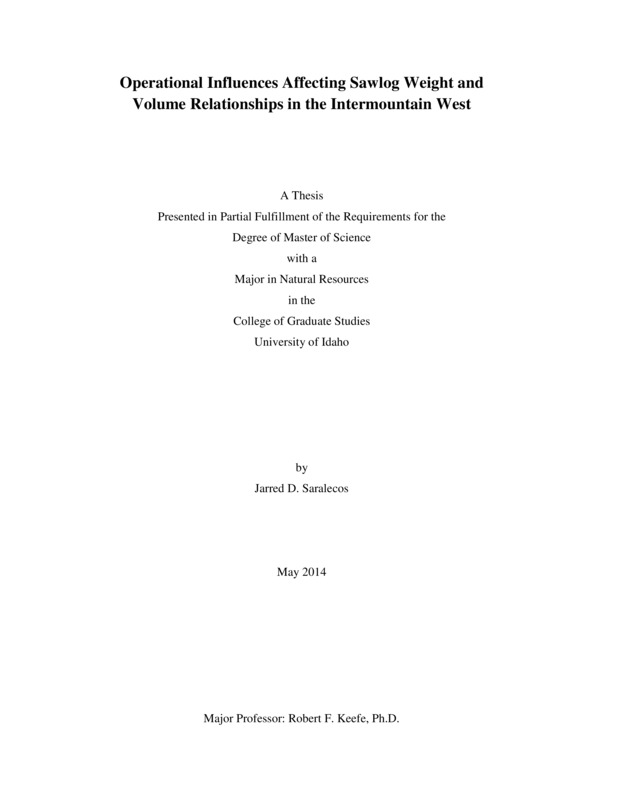Operational Influences Affecting Sawlog Weight and Volume Relationships in the Intermountain West
Saralecos, Jarred Douglas. (2014). Operational Influences Affecting Sawlog Weight and Volume Relationships in the Intermountain West. Theses and Dissertations Collection, University of Idaho Library Digital Collections. https://www.lib.uidaho.edu/digital/etd/items/saralecos_idaho_0089m_10228.html
- Title:
- Operational Influences Affecting Sawlog Weight and Volume Relationships in the Intermountain West
- Author:
- Saralecos, Jarred Douglas
- Date:
- 2014
- Keywords:
- forestry log scaling weight scaling weight to volume
- Program:
- Natural Resources
- Subject Category:
- Forestry
- Abstract:
-
Log scaling is a necessary and prevalent part of the forest products industry. Used to quantify production, assess inventory, and quantify the output of finished products as the basis for financial transactions, log scaling practices can affect the profitability of transactions among landowners, logging contractors, and mills. Decreases in average sawlog size combined with increases in scaled volumes at mills in recent decades has led to a transition toward faster and more efficient methods for assessing log volume than conventional scaling that is both accurate and consistent. The practice of weight scaling sawlogs, coupled with sample scaling methods that establish loaded truck weight to volume relationships, has grown beyond its original roots in pulpwood production and is quickly becoming a common method of sawlog volume determination at mills across the North America. Using weight scaling in connection with a sample scaling process or establishment of stratified conversion factors can reduce use of board foot log rules that are known to have limitations, as well as providing greater accuracy and consistency in predicting volume estimates of forest products.
The research within this thesis is focused on improving weight to volume (W-V) sawlog relationships, by advancing our understanding of environmental and scaling factors and applying that knowledge to quantify weight scaling conversion factors in Idaho. The work first evaluates the development and limitations of weight scaling procedures as they relate to technological improvements and a changing forest products landscape. This demonstrates that while various forested regions within the United States found early success implementing weight scaling procedures, alterations in climate, product, and topography are capable of significantly adjusting conversion factors. These findings are then explored through mapping moisture content changes in felled Pseudotsuga menziesii sawlogs. Taking advantage of the ability to assess accurate stem moisture content, it was shown that stem diameter, vapor pressure deficit, harvest method, and time are reliable indicators of stem moisture content. This project is intended as a proof of concept, meant to show how W-V relationships can shift across seasonal intervals. These understandings are then applied to the landscape scale and applied spatially to understand the driving factors behind and predict W-V conversion factors for commercial sawlogs across Idaho. The Random Forest produced model improvement ratio results identifying significant factors in weight scaling and subsequent mixed-model regression worked to establish an updated means of determining W-V relationships. This body of work; 1) improves the understanding of how weight scaling developed and the limitations that it contains; 2) demonstrates the impact of moisture loss on W-V relationships, potentially affecting profit yields; and 3) provides a quantitative understanding of the environmental, topographical, and spatial variability in W-V relationships across Idaho by applying Random Forest and mixed-model regression.
- Description:
- masters, M.S., Natural Resources -- University of Idaho - College of Graduate Studies, 2014
- Major Professor:
- Keefe, Robert F
- Committee:
- Brooks, Randall H; Johnson, Leonard R
- Defense Date:
- 2014
- Identifier:
- Saralecos_idaho_0089M_10228
- Type:
- Text
- Format Original:
- Format:
- application/pdf
- Rights:
- In Copyright - Educational Use Permitted. For more information, please contact University of Idaho Library Special Collections and Archives Department at libspec@uidaho.edu.
- Standardized Rights:
- http://rightsstatements.org/vocab/InC-EDU/1.0/

